Background of the project
The widespread application of the Internet has brought great convenience to life. Therefore, the hospital appointment registration management is combined with the current network, and Java technology is used to build the hospital appointment registration system to realize the informatization of hospital appointment registration. This can play a significant role in further improving the development of hospital appointment registration management and enriching hospital appointment registration management experience.
The hospital appointment registration system can be widely and comprehensively promoted through the Internet, so that as many users as possible can understand and be familiar with the convenience and efficiency of the hospital appointment registration system. It not only provides services to the public, but also Promote yourself and let more people know about yourself. For hospital appointment registration, if you have your own system, you can get better management through the system and improve your image at the same time.
The current status and trend of this system design, from the design of requirements, structure, database, etc. to the implementation of the system, respectively for administrators, users and doctors. The content of the paper shows the development process from the aspects of system design, description, implementation, analysis, and testing. This system selects a feasible development plan based on the actual situation, and uses the Java programming language and MySQL database to realize all the functions of the system. Next, the system is tested to test whether there are loopholes in the system and test user permissions to improve the system. The final system Completion meets relevant standards.
feature design
Function module diagram
In order to better clarify the overall idea of this system, the system is expressed in the form of a structure diagram. The functional structure diagram of the design and implementation of the hospital appointment registration system is as follows:

ER diagram is a diagram composed of entities and their relationships. The E/R diagram can clearly describe the mutual relationships between entities involved in the system. The main key entities in the system are as follows:
(1) The outpatient information E/R diagram is as follows:

(2) Doctor information The E/R diagram is shown below:

Function screenshot
Hospital appointment registration management system, you can view the homepage, outpatient information, announcement information, message board, personal center, backend management and other content on the system homepage
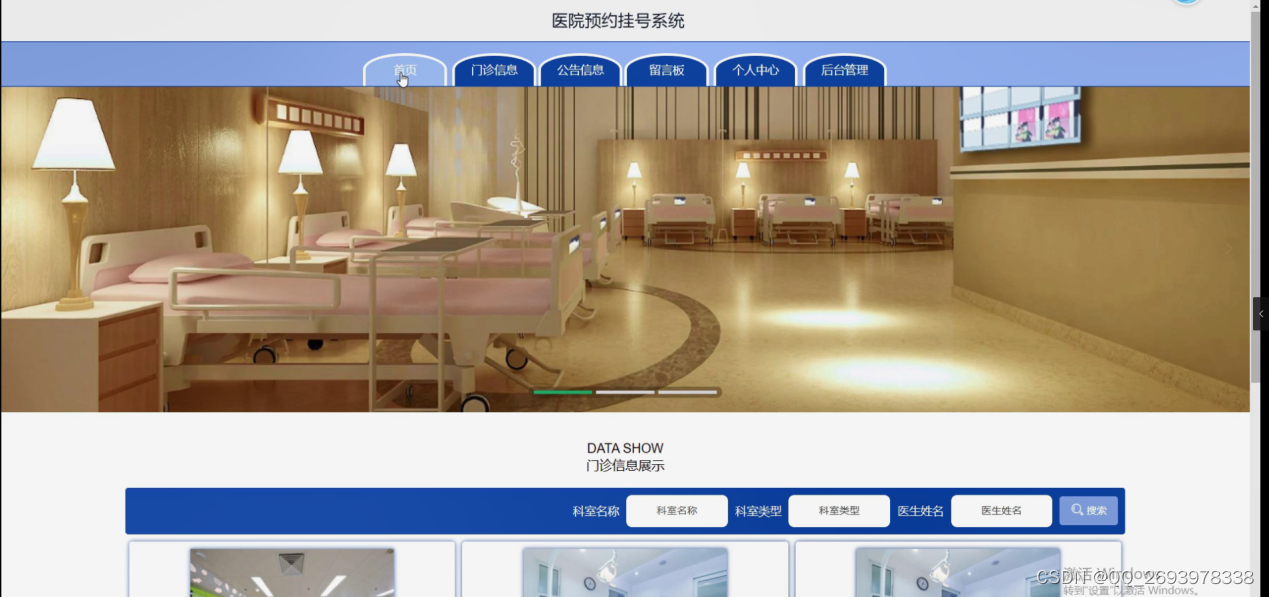
Outpatient information, on the outpatient information page You can check the department name, department type, pictures, doctor's work number, doctor's name, professional title, registration fee, number of appointments available, work date, schedule, doctor introduction and other information for appointment registration, comment or collection operations< a i=2> Message board, on the message board page, you can submit or reset immediately by filling in the message content, uploading pictures and other information, and you can also reply to the message content and pictures Personal center, On the personal center page, update the information by filling in the account number, password, name, gender, age, mobile phone, email, address, ID card, uploaded pictures, etc. You can also perform detailed operations on my collection as needed The user enters the system background, fills in the user name and password as required on the login page, selects the role and other information, and clicks login to log in After the administrator logs in to the system, he can modify the homepage and personal center , user management, doctor management, outpatient information management, appointment registration management, appointment cancellation management, appointment change notification management, message board management, system management and other functions for corresponding operation management User management, in The user management page can view, modify and delete account, name, gender, age, mobile phone, email, address, ID card, pictures and other contents Doctor management can be done on the doctor management page View, modify and delete doctor's job number, doctor's name, gender, age, professional title, phone number, avatar and other contents Outpatient information management, on the outpatient information management page, you can modify department name, department name, etc. View, modify, view comments or delete department type, doctor's job number, doctor's name, professional title, registration fee, number of appointments available, work date, department pictures and other contents Appointment registration management, in The appointment registration management page can review the department name, department type, doctor's work number, doctor's name, professional title, registration fee, number of appointments available, appointment time, appointment instructions, account number, name, whether to review, review reply, whether to pay, etc. , appointment rescheduling notification, view, modify and delete operations Cancel appointment management. On the cancellation appointment management page, you can modify the department name, department type, doctor's work number, doctor's name, professional title, cancellation time, cancellation Review, view, modify and delete content such as reasons, account numbers, names, whether to review, review responses, etc. Management of appointment rescheduling notifications. On the rescheduling notification management page, you can modify the title, notification content, and notifications. View, modify and delete time, account number, name and other contents
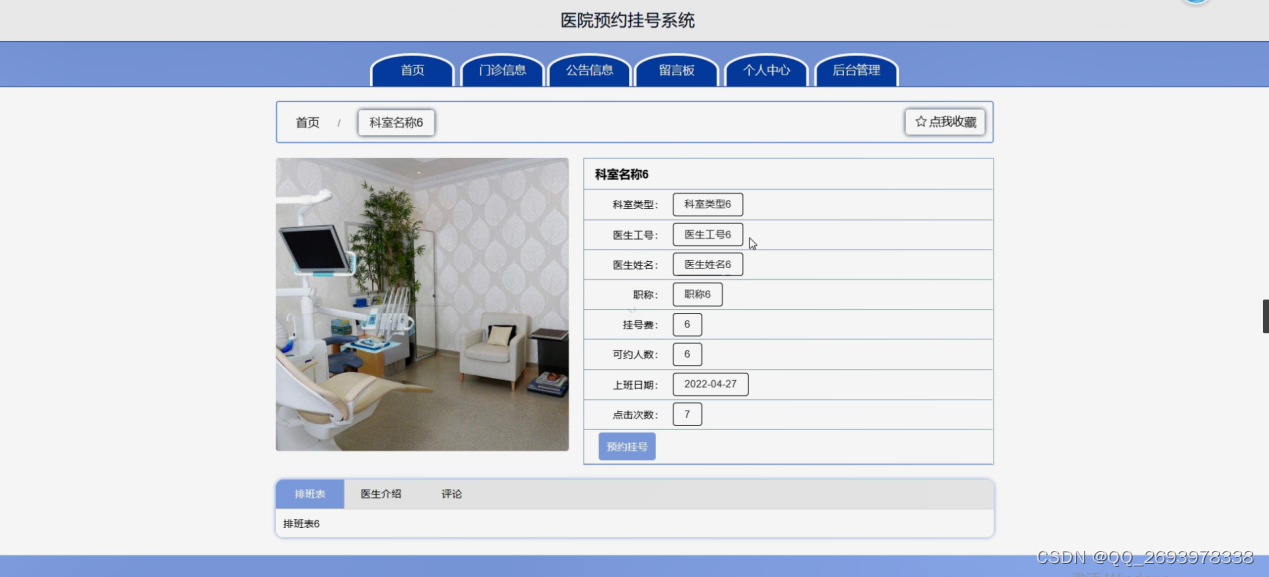
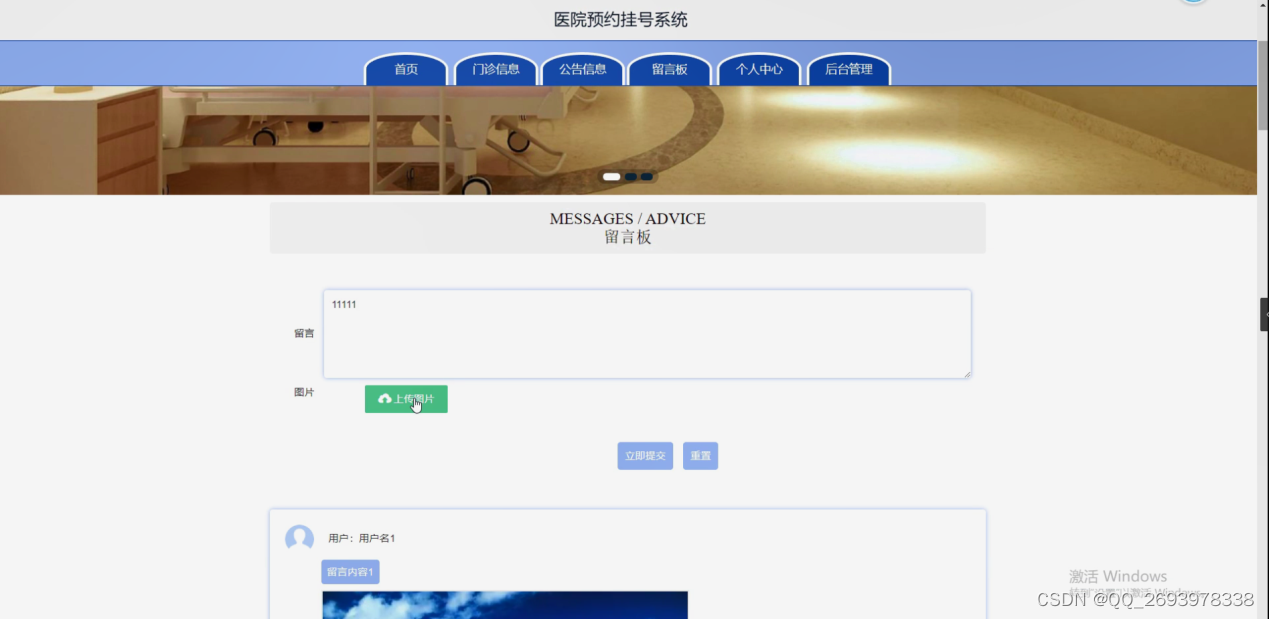

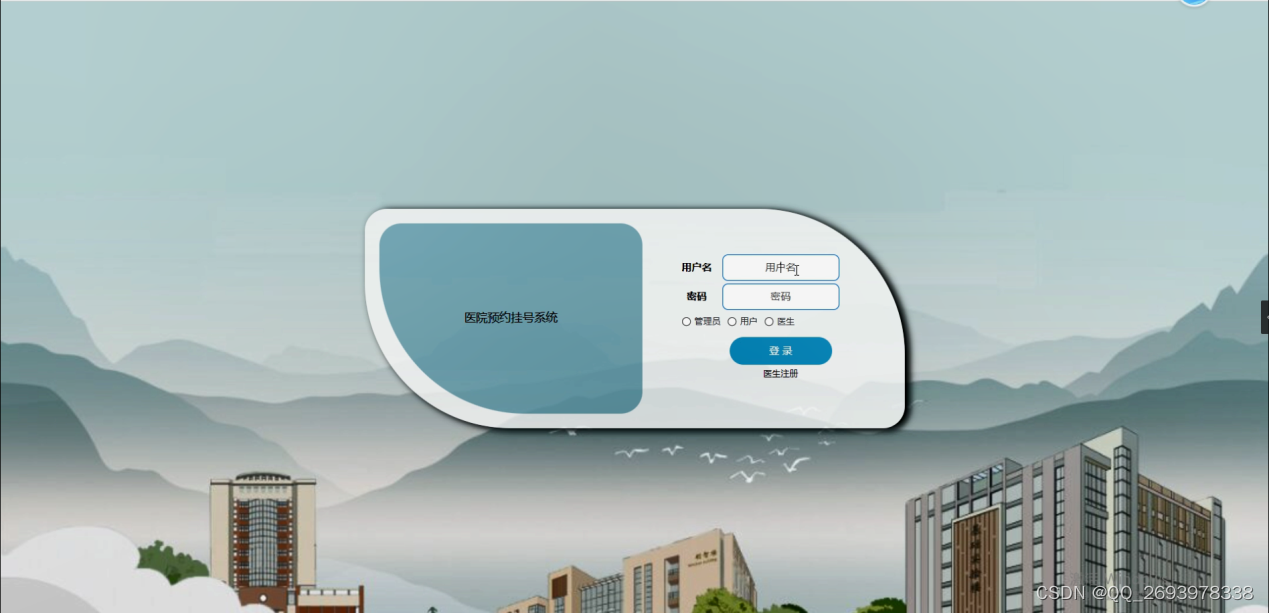
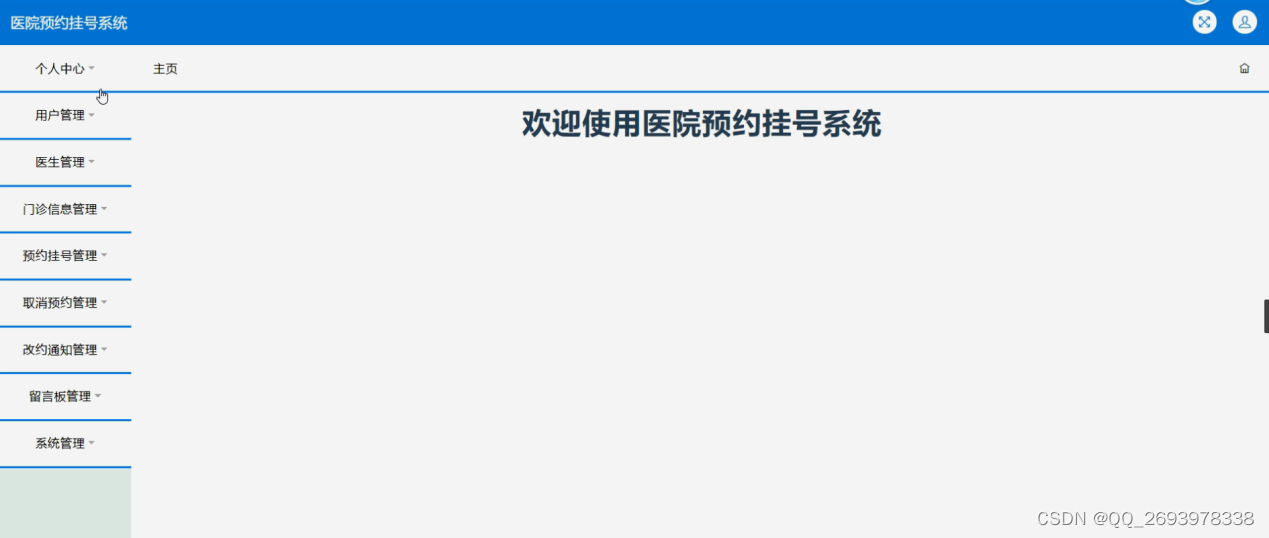
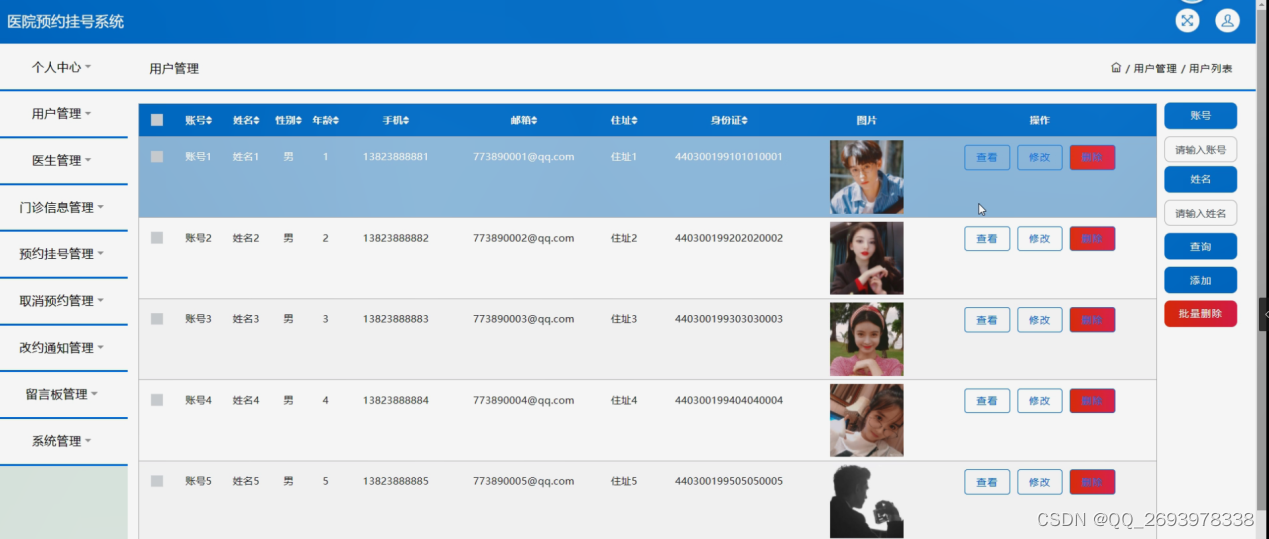
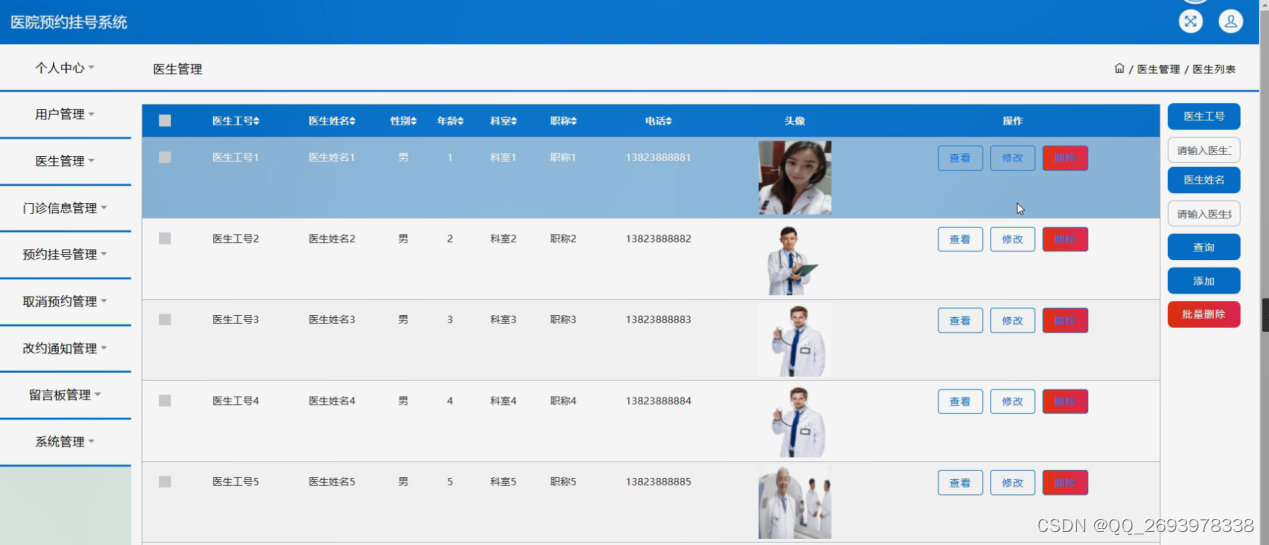


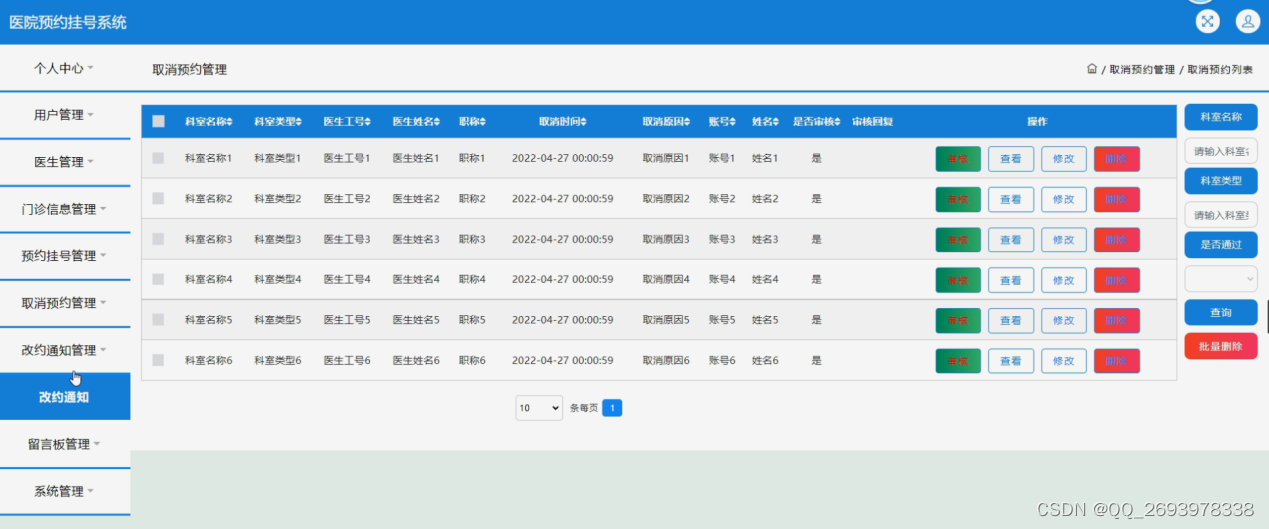
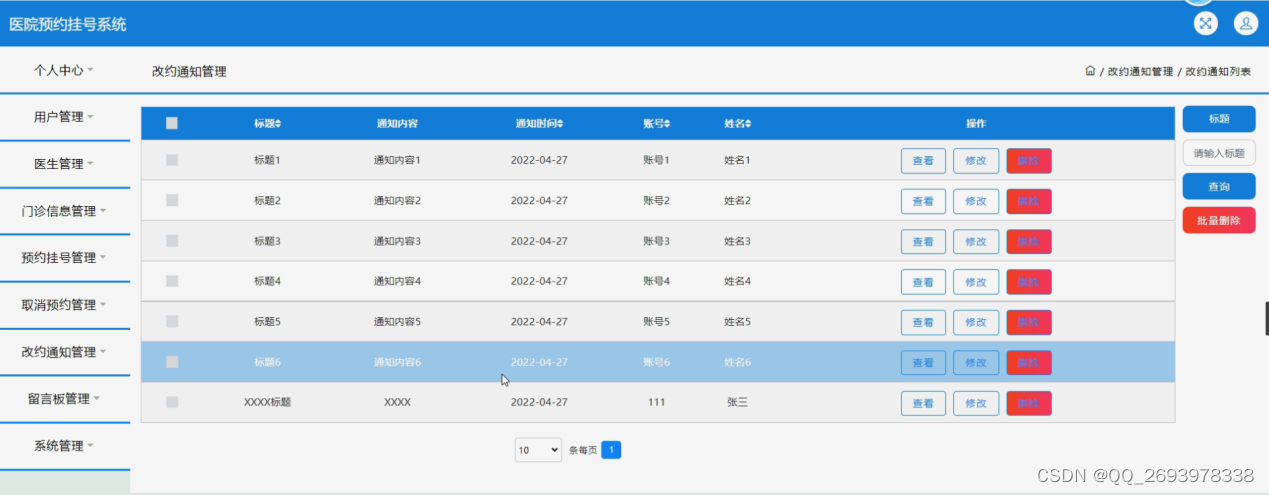
Related code
Database configuration
# Tomcat
server:
tomcat:
uri-encoding: UTF-8
port: 8080
servlet:
context-path: /springbootr1tjf
spring:
datasource:
driverClassName: com.mysql.jdbc.Driver
url: jdbc:mysql://127.0.0.1:3306/springbootr1tjf?useUnicode=true&characterEncoding=utf-8&useJDBCCompliantTimezoneShift=true&useLegacyDatetimeCode=false&serverTimezone=GMT%2B8
username: root
password: 123456
# driverClassName: com.microsoft.sqlserver.jdbc.SQLServerDriver
# url: jdbc:sqlserver://127.0.0.1:1433;DatabaseName=springbootr1tjf
# username: sa
# password: 123456
servlet:
multipart:
max-file-size: 10MB
max-request-size: 10MB
resources:
static-locations: classpath:static/,file:static/
#mybatis
mybatis-plus:
mapper-locations: classpath*:mapper/*.xml
#实体扫描,多个package用逗号或者分号分隔
typeAliasesPackage: com.entity
global-config:
#主键类型 0:"数据库ID自增", 1:"用户输入ID",2:"全局唯一ID (数字类型唯一ID)", 3:"全局唯一ID UUID";
id-type: 1
#字段策略 0:"忽略判断",1:"非 NULL 判断"),2:"非空判断"
field-strategy: 2
#驼峰下划线转换
db-column-underline: true
#刷新mapper 调试神器
refresh-mapper: true
#逻辑删除配置
logic-delete-value: -1
logic-not-delete-value: 0
#自定义SQL注入器
sql-injector: com.baomidou.mybatisplus.mapper.LogicSqlInjector
configuration:
map-underscore-to-camel-case: true
cache-enabled: false
call-setters-on-nulls: true
#springboot 项目mybatis plus 设置 jdbcTypeForNull (oracle数据库需配置JdbcType.NULL, 默认是Other)
jdbc-type-for-null: 'null'
Controller
package com.controller;
import java.util.Arrays;
import java.util.Calendar;
import java.util.Date;
import java.util.Map;
import javax.servlet.http.HttpServletRequest;
import org.springframework.beans.factory.annotation.Autowired;
import org.springframework.stereotype.Controller;
import org.springframework.web.bind.annotation.GetMapping;
import org.springframework.web.bind.annotation.PathVariable;
import org.springframework.web.bind.annotation.PostMapping;
import org.springframework.web.bind.annotation.RequestBody;
import org.springframework.web.bind.annotation.RequestMapping;
import org.springframework.web.bind.annotation.RequestParam;
import org.springframework.web.bind.annotation.ResponseBody;
import org.springframework.web.bind.annotation.RestController;
import com.annotation.IgnoreAuth;
import com.baomidou.mybatisplus.mapper.EntityWrapper;
import com.entity.TokenEntity;
import com.entity.UserEntity;
import com.service.TokenService;
import com.service.UserService;
import com.utils.CommonUtil;
import com.utils.MPUtil;
import com.utils.PageUtils;
import com.utils.R;
import com.utils.ValidatorUtils;
/**
* 登录相关
*/
@RequestMapping("users")
@RestController
public class UserController{
@Autowired
private UserService userService;
@Autowired
private TokenService tokenService;
/**
* 登录
*/
@IgnoreAuth
@PostMapping(value = "/login")
public R login(String username, String password, String captcha, HttpServletRequest request) {
UserEntity user = userService.selectOne(new EntityWrapper<UserEntity>().eq("username", username));
if(user==null || !user.getPassword().equals(password)) {
return R.error("账号或密码不正确");
}
String token = tokenService.generateToken(user.getId(),username, "users", user.getRole());
return R.ok().put("token", token);
}
/**
* 注册
*/
@IgnoreAuth
@PostMapping(value = "/register")
public R register(@RequestBody UserEntity user){
// ValidatorUtils.validateEntity(user);
if(userService.selectOne(new EntityWrapper<UserEntity>().eq("username", user.getUsername())) !=null) {
return R.error("用户已存在");
}
userService.insert(user);
return R.ok();
}
/**
* 退出
*/
@GetMapping(value = "logout")
public R logout(HttpServletRequest request) {
request.getSession().invalidate();
return R.ok("退出成功");
}
/**
* 密码重置
*/
@IgnoreAuth
@RequestMapping(value = "/resetPass")
public R resetPass(String username, HttpServletRequest request){
UserEntity user = userService.selectOne(new EntityWrapper<UserEntity>().eq("username", username));
if(user==null) {
return R.error("账号不存在");
}
user.setPassword("123456");
userService.update(user,null);
return R.ok("密码已重置为:123456");
}
/**
* 列表
*/
@RequestMapping("/page")
public R page(@RequestParam Map<String, Object> params,UserEntity user){
EntityWrapper<UserEntity> ew = new EntityWrapper<UserEntity>();
PageUtils page = userService.queryPage(params, MPUtil.sort(MPUtil.between(MPUtil.allLike(ew, user), params), params));
return R.ok().put("data", page);
}
/**
* 列表
*/
@RequestMapping("/list")
public R list( UserEntity user){
EntityWrapper<UserEntity> ew = new EntityWrapper<UserEntity>();
ew.allEq(MPUtil.allEQMapPre( user, "user"));
return R.ok().put("data", userService.selectListView(ew));
}
/**
* 信息
*/
@RequestMapping("/info/{id}")
public R info(@PathVariable("id") String id){
UserEntity user = userService.selectById(id);
return R.ok().put("data", user);
}
/**
* 获取用户的session用户信息
*/
@RequestMapping("/session")
public R getCurrUser(HttpServletRequest request){
Long id = (Long)request.getSession().getAttribute("userId");
UserEntity user = userService.selectById(id);
return R.ok().put("data", user);
}
/**
* 保存
*/
@PostMapping("/save")
public R save(@RequestBody UserEntity user){
// ValidatorUtils.validateEntity(user);
if(userService.selectOne(new EntityWrapper<UserEntity>().eq("username", user.getUsername())) !=null) {
return R.error("用户已存在");
}
userService.insert(user);
return R.ok();
}
/**
* 修改
*/
@RequestMapping("/update")
public R update(@RequestBody UserEntity user){
// ValidatorUtils.validateEntity(user);
UserEntity u = userService.selectOne(new EntityWrapper<UserEntity>().eq("username", user.getUsername()));
if(u!=null && u.getId()!=user.getId() && u.getUsername().equals(user.getUsername())) {
return R.error("用户名已存在。");
}
userService.updateById(user);//全部更新
return R.ok();
}
/**
* 删除
*/
@RequestMapping("/delete")
public R delete(@RequestBody Long[] ids){
userService.deleteBatchIds(Arrays.asList(ids));
return R.ok();
}
}
Business layer (Service)
package com.service;
import java.util.List;
import java.util.Map;
import org.apache.ibatis.annotations.Param;
import com.baomidou.mybatisplus.mapper.Wrapper;
import com.baomidou.mybatisplus.service.IService;
import com.entity.UserEntity;
import com.utils.PageUtils;
/**
* 系统用户
*/
public interface UserService extends IService<UserEntity> {
PageUtils queryPage(Map<String, Object> params);
List<UserEntity> selectListView(Wrapper<UserEntity> wrapper);
PageUtils queryPage(Map<String, Object> params,Wrapper<UserEntity> wrapper);
}
Data access layer (Dao)
package com.dao;
import java.util.List;
import org.apache.ibatis.annotations.Param;
import com.baomidou.mybatisplus.mapper.BaseMapper;
import com.baomidou.mybatisplus.mapper.Wrapper;
import com.baomidou.mybatisplus.plugins.pagination.Pagination;
import com.entity.UserEntity;
/**
* 用户
*/
public interface UserDao extends BaseMapper<UserEntity> {
List<UserEntity> selectListView(@Param("ew") Wrapper<UserEntity> wrapper);
List<UserEntity> selectListView(Pagination page,@Param("ew") Wrapper<UserEntity> wrapper);
}